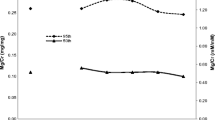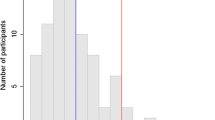Abstract
Background
Reference values for urinary calcium (Ca) and other solutes/creatinine (Cr) ratios in infants and young children are scarce. Its variation with type of lactation administered, breastfed (BF) or formula (F), is incompletely known.
Methods
A total of 511 spot urine samples from 136 children, aged 6 days to < 5 years, was collected. Urine was collected no fasting in infants < 18 months and first morning fasting in children aged 2.5–4 years. Urinary osmolality, Cr, urea, Ca, phosphate (P), magnesium (Mg), and uric acid (UA) were determined. Values are expressed as solute-to-Cr ratio.
Results
Urinary values were grouped according to the child’s age: 6–17 days (G1), 1–5 months (G2), 6–12 months (G3), 13–18 months (G4), and 2.5–4 years (G5). G1 was excluded; Ca/Cr and UA/Cr (95th percentile) decreased with age (G2 vs. G5) from 1.64 to 0.39 and 2.33 to 0.83 mg/mg, respectively. The P/Cr median rises significantly with age from 0.31 (G2) to 1.66 mg/mg (G5). Mg/Cr was similar in all groups (median 0.20, 95th percentile 0.37 mg/mg). Ca/Cr (95th percentile) of BF infants was 1.80 mg/mg (< 3 months) and 1.63 mg/mg (3–5 months), much higher than F infants (0.93 and 0.90 mg/mg, respectively). P/Cr and P/Ca were lower in BF infants.
Conclusions
Values for urinary Ca/Cr, P/Cr, Mg/Cr, and UA/Cr in infants and children < 5 years were updated. BF infants < 6 months showed higher Ca/Cr and lower P/Cr than F infants. New cutoff values to diagnose hypercalciuria in infants < 6 months, according to the type of lactation, are proposed.
Graphical abstract

A higher resolution version of the Graphical abstract is available as Supplementary information

Similar content being viewed by others
Data availability
The datasets generated and analyzed during the current study are available from the corresponding author on reasonable request.
References
Nordin BEC (1959) Assessment of calcium excretion from the urinary calcium/creatinine ratio. Lancet 74:368–371
Ghazali S, Barratt TM (1974) Urinary excretion of calcium and magnesium in children. Arch Dis Child 49:97–101. https://doi.org/10.1136/adc.49.2.97
Hernández Marco R, Nuñez Gomez F, Martinez Costa C, Fons Moreno J, Peris Vidal A, Brines Solanes J (1988) Urinary excretion of calcium, magnesium, uric acid and oxalic acid in normal children. An Esp Pediatr 29:99–104
García Nieto VM, Luis Yanes MI, Arango Sancho P (2014) Basic renal function tests reviewed. Is the 24-hour urine collection on the decline in paediatrics? An Pediatr (Barc) 80:275–277. https://doi.org/10.1016/j.anpedi.2014.03.009
Sargent JD, Stukel TA, Kresel J, Klein RZ (1993) Normal values for random urinary calcium to creatinine ratios in infancy. J Pediatr 123:393–397. https://doi.org/10.1016/S0022-3476(05)81738-X
Ariceta G, Rodriguez Soriano J, Vallo A (1996) Renal magnesium handling in infants and children. Acta Paediatr 85:1019–1023
Matos V, Van Melle G, Boulat O, Markert M, Bachmann C, Guignard JP (1997) Urinary phosphate/creatinine, calcium/creatinine and magnesium/creatinine ratios in a healthy pediatric population. J Pediatr 131:252–257. https://doi.org/10.1016/S0022-3476(97)70162-8
Matos V, Van Melle G, Werner D, Bardy D, Guignard JP (1999) Urinary oxalate and urate to creatinine ratios in a healthy pediatric population. Am J Kidney Dis 34:e1. https://doi.org/10.1053/AJKD034000e6
Vachvanichsanong P, Lebel L, Moore E (2000) Urinary calcium excretion in healthy Thai children. Pediatr Nephrol 14:847–850. https://doi.org/10.1007/s004679900229
So NP, Osorio AV, Simon SD, Alon US (2001) Normal urinary calcium/creatinine ratios in African-American and Caucasian children. Pediatr Nephrol 16:133–139. https://doi.org/10.1007/s004670000510
Ceran O, Akin M, Aktürk Z, Ozkozaci T (2003) Normal urinary calcium/creatinine ratios in Turkish children. Indian Pediatr 40:884–887
Safarinejad MR (1993) Urinary mineral excretion in healthy Iranian children. Pediatr Nephrol 18:140–144. https://doi.org/10.1007/s00467-002-1020-1
Erol I, Buyan N, Özkaya O, Sahin F, Beyazova SO, Hasanoglu E (2009) Reference values for urinary calcium, sodium and potassium in healthy newborns, infants and children. Turk J Pediatr 51:6–13
Poyrazoglu HM, Dussunsel R, Yazici C, Durmaz H, Dursum I, Sahin H, Gündüz Z, Gürgöze M (2009) Urinary uric acid:creatinine ratios in healthy Turkish children. Pediatr Int 51:526–529. https://doi.org/10.1111/j.1442-200X.2008.02785.x
Ferré N, Rubio-Torrents C, Luque V, Closa-Monasterolo R, Grote V, Koletzko B, Socha P, Gruszfeld D, Langhendries JP, Sengier A, Verduci E, Escribano J, European Childhood Obesity Project Group (2017) Influence of feeding types during the first months of life on calciuria levels in healthy infants: a secondary analysis from a randomized clinical trial. Ann Nutr Metab 70:139. https://doi.org/10.1159/000468156
McCrory WW, Forman CW, McNamara H, Barnett HL (1952) Renal excretion of inorganic phosphate in newborn infants. J Clin Invest 31:357–366. https://doi.org/10.1172/JCI102616
Reusz GS, Dobos M, Byrd D, Sallay P, Miltényi M, Tulassay T (1995) Urinary calcium and oxalate excretion in children. Pediatr Nephrol 9:39–44. https://doi.org/10.1007/BF00858966
Bistarakis L, Voskaki I, Lambadaridis J, Sereti H, Sbyrakis S (1986) Renal handling of phosphate in the first months of life. Arch Dis Child 61:677–681. https://doi.org/10.1136/adc.61.7.677
Hillman LS, Chow W, Salmons S, Weaver E, Erickson M, Hansen J (1988) Vitamin D metabolism, mineral homeostasis, and bone mineralization in term infants fed human milk, cow milk-based formula, or soy-based formula. J Pediatr 112:864–874. https://doi.org/10.1016/s0022-3476(88)80206-3
Ubalde E, García de Jalón A, Abad A, Loris C (1988) Urinary excretion of calcium in healthy children. Multicenter collaborative study. Nefrologia 3:224–230
Butani L, Kalia A (2004) Idiopathic hypercalciuria in children - how valid are the existing diagnostic criteria? Pediatr Nephrol 19:577–582. https://doi.org/10.1007/s00467-004-1470-8
Hoppe B, Hesse A, Neuhaus T, Fanconi S, Blau N, Roth B, Leumann E (1997) Influence of nutrition on urinary oxalate and calcium in preterm and term infants. Pediatr Nephrol 11:687–690. https://doi.org/10.1007/s004670050366
Ozkaya O, Buyan N, Erol I, Atalay Y, Beyazova U, Sahin F, Söylemezoglu O (2005) The relationship between urinary calcium, sodium, and potassium excretion in full-term healthy newborns. Turk J Pediatr 47:39–45
Saez-Torres C, Rodrigo D, Grases F, García-Raja AM, Gómez C, Lumbreras J, Frontera G (2014) Urinary excretion of calcium, magnesium, phosphate, citrate, oxalate, and uric acid by healthy schoolchildren using a 12-h collection protocol. Pediatr Nephrol 29:1201–1208. https://doi.org/10.1007/s00467-014-2755-1
El Mallah C, Ghattas H, Shatila D, Francis S, Merhi K, Hlais S, Toufeili I, Obeid O (2016) Urinary magnesium, calcium, and phosphorus to creatinine ratios of healthy elementary school Lebanese children. Biol Trace Elem Res 170:264–270. https://doi.org/10.1007/s12011-015-0484-3
Paunier L, Borgeaud M, Wyss M (1970) Urinary excretion of magnesium and calcium in normal children. Helv Paediatr Acta 25:577–584
Simecková A, Zamrazil V, Cerovska J (1998) Calciuria, magnesuria and creatininuria-relation to age. Physiol Res 47:35–40
Yilmaz N, Yüksel S, Altintas F, Kocyigit A (2021) Nephrolithiasis during the first 6 months of life in exclusively breastfed infants. Pediatr Nephrol 36:1227–1231. https://doi.org/10.1007/s00467-020-04815-w
Ariceta G, Rodríguez-Soriano J, Vallo A (1995) Magnesium homeostasis in premature and full-term neonates. Pediatr Nephrol 9:423–427. https://doi.org/10.1007/BF00866716
Institute of Medicine (1997) Dietary reference intakes for calcium, phosphorus, magnesium, vitamin D, and fluoride. National Academies Press, Washington, DC
Bellos I, Fitrou G, Pergialiotis V, Perrea DN, Papantoniou N, Daskalakis G (2019) Random urine uric acid to creatinine and prediction of perinatal asphyxia: a meta-analysis. J Matern Fetal Neonatal Med 32:3864–3870. https://doi.org/10.1080/14767058.2018.1471677
van der Watt G, Omar F, Brink A, McCulloch M (2016) Laboratory investigation of the child with suspected renal disease. In: Avner ED, Harmon WE, Niaudet P, Yoshikawa N, Emma F, Goldstein SL (eds) Pediatric Nephrology, 7th edn. Springer, Heidelberg, pp 613–636
García Nieto VM, Moraleda T, Hernández González MJ (2021) Renal lithiasis in history. Diagnostic approach to renal lithiasis in childhood. Metabolic abnormalities causing stones. The concept of prelithiasis. Preventive treatment. In: Exeni R, García-Nieto V, Medeiros M, Santos F (eds) Paediatric nephrology. University of Oviedo and Autonomous University of Mexico, Oviedo, pp 991–997
Sanchez Bayle M, Martínez Jiménez AL, Ruiz-Jarabo C, Asensio J, Amaiz P, Vila S (1992) Urinary excretion of uric acid in childhood and adolescence. Nefrologia 12:239–243
Chen YH, Lee AJ, Chen CH, Chesney RW, Stapleton FB, Roy S 3rd (1994) Urinary mineral excretion among normal Taiwanese children. Pediatr Nephrol 8:36–39. https://doi.org/10.1007/BF00868256
Stapleton FB (1978) Uric acid excretion in normal children. J Pediatr 92:911–914. https://doi.org/10.1016/S0022-3476(78)80359-X
Vázquez Martul M, Sánchez Bayle M, Écija JL, Montalvo N, Sánchez Medina D, Otero J (1988) Normal values of urinary excretion of uric acid in childhood. Nefrologia 8:250–254
Karlén J, Aperia A, Zetterström R (1985) Renal excretion of calcium and phosphate in preterm and term infants. J Pediatr 106:814–819. https://doi.org/10.1016/s0022-3476(85)80364-4
Fomon SJ, Nelson SE (1993) Calcium, phosphorus, magnesium, and sulfur. In: Fomon SJ (ed) Nutrition in normal infants. Mosby-Yearbook Inc, St. Louis, pp 192–216
Mathes M, Maas C, Bleeker C, Vek J, Bernhard W, Peter A, Poets CF, Franz AR (2018) Effect of increased enteral protein intake on plasma and urinary urea concentrations in preterm infants born at <32 weeks gestation and <1500 g birth weight enrolled in a randomized controlled trial - a secondary analysis. BMC Pediatr 18:154. https://doi.org/10.1186/s12887-018-1136-5
Rowe J, Rowe D, Horak E, Spackman T, Saltzman R, Robinson S, Philipps RJ (1984) Hypophosphatemia and hypercalciuria in small premature infants fed human milk: evidence for inadequate dietary phosphorus. J Pediatr 104:112–117. https://doi.org/10.1016/s0022-3476(84)80606-x
Hillman LS (1990) Mineral and vitamin D adequacy in infants fed human milk or formula between 6 and 12 months of age. J Pediatr 117:S134-142. https://doi.org/10.1016/s0022-3476(05)80011-3
Dror DK, Allen LH (2018) Overview of nutrients in human milk. Adv Nutr 9(Suppl 1):278S-294S. https://doi.org/10.1093/advances/nmy022
Academy American, of Pediatrics. Committee on Nutrition, (1998) Pediatric Nutrition Handbook, 4th edn. American Academy of Pediatrics, Elk Grove Village, pp 655–658
ESPGHAN Committee on Nutrition, Agostoni C, Braegger C, Decsi T, Kolacek S, Koletzko B, Michaelsen KF, Mihatsch W, Moreno LA, Puntis J, Shamir R, Szjewska H, Turck D, van Goudoever J (2009) Breast-feeding: a commentary by the ESPGHAN Committee on Nutrition. J Pediatr Gastroenterol Nutr 49:125. https://doi.org/10.1097/MPG.0b013e31819f1e05
Metz MP (2006) Determining urinary calcium/creatinine cut-offs for the paediatric population using published data. Ann Clin Biochem 43:398–401. https://doi.org/10.1258/000456306778520106
Author information
Authors and Affiliations
Contributions
A. Peris Vidal and R. Hernández contributed to the study conception and design. Material preparation and data collection were performed by A. Peris Vidal and statistical analysis by R. Hernández. The first draft of the manuscript was written by A. Peris Vidal and R. Hernández, and all authors commented on the previous versions of the manuscript. All authors interpreted the data, revised the manuscript, provided intellectual content, and approved the submitted version.
Corresponding author
Ethics declarations
Ethics approval
The procedures used in this study adhere to the tenets of the Declaration of Helsinki. Approval was obtained from the Ethics Committee for Clinical Research of the Hospital Clínico Universitario, Valencia, Spain.
Consent to participate
Written informed consent was obtained from the parents of the patients.
Competing interests
The authors declare no competing interests.
Additional information
Publisher's Note
Springer Nature remains neutral with regard to jurisdictional claims in published maps and institutional affiliations.
Supplementary Information
Below is the link to the electronic supplementary material.
Rights and permissions
Springer Nature or its licensor (e.g. a society or other partner) holds exclusive rights to this article under a publishing agreement with the author(s) or other rightsholder(s); author self-archiving of the accepted manuscript version of this article is solely governed by the terms of such publishing agreement and applicable law.
About this article
Cite this article
Peris Vidal, A., Ferrando Monleón, S., Marín Serra, J. et al. Urinary excretion of calcium, phosphate, magnesium, and uric acid in healthy infants and young children. Influence of feeding practices in early infancy. Pediatr Nephrol 39, 761–770 (2024). https://doi.org/10.1007/s00467-023-06145-z
Received:
Revised:
Accepted:
Published:
Issue Date:
DOI: https://doi.org/10.1007/s00467-023-06145-z




